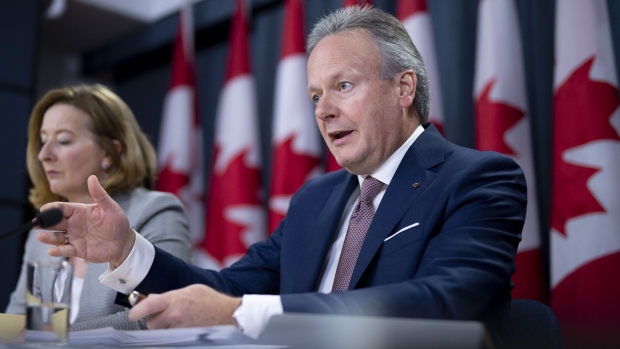Dec 5, 2018
Bank of Canada pares back optimism as it holds rates steady
, Bloomberg News

The Bank of Canada walked back some of its enthusiasm about the nation’s outlook in a decision that kept interest rates unchanged, saying the economy may have more capacity than previously thought to grow without fueling inflation.
The Ottawa-based central bank kept its overnight benchmark rate at 1.75 per cent, reiterating it expects to eventually remove all monetary stimulus from the economy, but its statement was more guarded than the last one in October.
Citing moderating global growth, a “materially weaker” outlook for the oil sector, a faster-than-expected deceleration of inflation, a drop in business investment and downward historical revisions to output, policy makers said “there may be additional room for non-inflationary growth.”
“Governing Council continues to judge that the policy interest rate will need to rise into a neutral range to achieve the inflation target,” the bank said in the statement, adding the appropriate pace of increases will depend on the “effect of higher interest rates on consumption and housing, and global trade policy developments.”
“The persistence of the oil price shock, the evolution of business investment, and the Bank’s assessment of the economy’s capacity will also factor importantly into our decisions about the future stance of monetary policy,” the bank said.
Less Confident
The less-confident tone is an acknowledgement of developments over the past few weeks that have cast doubt on the strength of the nation’s expansion and prompted investors to scale back the expected pace of future rate increases.
Governor Stephen Poloz will have an opportunity to discuss the outlook in more detail when he delivers a speech Thursday in Toronto.
As recently as October, investors were anticipating at least three more hikes by the end of next year -- but those expectations have dwindled to no more than two. Swaps trading suggests the Bank of Canada will cap its hiking cycle at 2.25 per cent, below its estimate of a “neutral” range for rates of between 2.5 per cent and 3.5 per cent.
The central bank noted the decline in business investment in the third quarter, though it suggested temporary factors were at least partly at play because of last summer’s heightened uncertainty around trade negotiations with the U.S.
“Business investment outside the energy sector is expected to strengthen with the signing of the USMCA, new federal government tax measures, and ongoing capacity constraints,” it said.
More Capacity
The central bank also indicated the economy may have more capacity to expand than it previously estimated because of “recent macroeconomic developments” and after Statistics Canada revised down some of its economic output numbers over the past three years -- a dovish statement that suggests there may be less need for tightening.
The country’s oil sector, which has been in a state of crisis after prices plunged, featured prominently in the statement. The Bank of Canada acknowledged the sharp decline in prices and the planned cuts in production, which have occurred since it released its last forecasts in October.
“In light of these developments and associated cutbacks in production, activity in Canada’s energy sector will likely be materially weaker than expected,” it said of an industry that generates more than 10 per cent of the nation’s exports receipts.
Inflation running above the central bank’s 2 per cent target is one key reason policy makers have wanted to raise rates. Another is that the economy continues to do relatively well. It grew by a Group-of-Seven-best 3.1 per cent in 2017, and has expanded at a healthy 2.2 per cent clip so far this year.
But the statement indicating the expected decline in inflation will be larger than forecast in coming months due to lower gasoline prices. Growth meanwhile, while coming in in the third quarter “in line” with projections has begun the fourth quarter with “less momentum.”
The bank added that inflation has been evolving as expected with core inflation tracking 2 per cent, “consistent with an economy that has been operating close to its capacity.”
--With assistance from Erik Hertzberg

